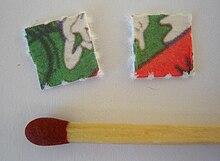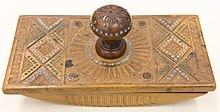Blotting paper
This article has multiple issues.Please helpimprove itor discuss these issues on thetalk page.(Learn how and when to remove these messages)
|


Blotting paperis a highly absorbent type ofpaperused to absorbinkor oil from writing material, particularly whenquillsorfountain penswere popular. It could also be used in testing how much oil is present in products. Blotting paper referred to as bibulous paper is mainly used inmicroscopyto remove excess liquids from the slide before viewing. Blotting paper has also been sold as a cosmetic to aid in the removal of skin oils and makeup.
Manufacture
[edit]Blotting paper is made from different materials of varying thickness, softness, etc. depending on the application. It is often made of cotton and manufactured on specialpaper machines.Blotting paper is reputed to be first referred to in the English language in the 15th century but there is a tradition in Norfolk, England that it was invented by accident atLyngMill on theRiver Wensum.[1]
It is reported that aBerkshire(England) paper mill worker failed to addsizingto a batch of paper that was being produced. The batch was discarded. Subsequently, someone tried to write on a piece of this discarded "scrap" paper and found that it rapidly absorbed any ink applied, making it unusable for writing. Its marked absorbency having been noted, however, led to its subsequently being produced and used as blotting paper, replacing sand, which was the material that had been used for absorbing superficial wet ink. In a time when most paper was produced from "rags", red/pink rags, from which it was difficult to remove all color and had generally been discarded, were now directed to the production of blotters, hence the historically characteristic pink color of blotters.[2][3]
Applications
[edit]Art
[edit]A form of blotter paper commonly known aswatercolor paperis produced for its absorbent qualities, allowing much better absorption of water and pigments than standard art or drawing papers. Although usually categorized as separate from blotting paper, differences in the constituents and thickness of blotting paper and watercolor paper are subtle, and making a distinction between the two is unnecessary as the production process is nearly identical.[original research?]
Chemical analyses
[edit]Blotting paper is used inchemical analysesas stationary phase inthin-layer chromatography.Blotting paper is also used in pool/spa maintenance to measurepHbalance. Small squares of blotting paper attached to disposable plastic strips are impregnated with pH sensitive compounds usually extracted fromlichens,especiallyRoccella tinctoria.These strips are used similarly tolitmusstrips, howeverfilter paperis usually used for litmus strips, generally to allow for the property of diffusion.[original research?]
Drugs
[edit]
Drugs active in microgram range, most notablyLSD,are commonly distributed illicitly on blotting paper. A liquid solution of the drug is applied to the blotting paper, which commonly is perforated into individual doses and artfully decorated with what is known asblotter art.Vanity blotter is blotter art that has not been exposed to LSD and is usually sold as a collectible, although inevitably much of this art ends up in illegal distribution. The artwork is printed onto blotter paper and then sometimes perforated into tiny squares or "tabs" which can be torn or cut apart.[4]Most blotter art designs have grid lines as part of the design to either aid in perforation or to be left as a cutting grid. Blotter as a delivery method allows for easy dosing of potent substances and easy sublingual administration of drugs which has made it increasingly popular as a preparation for other potent drugs including25I-NBOMeandalprazolam.[5]
Plain white LSD blotter without artwork is commonly referred to as WoW (White on White)[note 1]and is usually not perforated but rather gridded with a pen and sometimes laid on commonly obtained watercolor paper.
Writing
[edit]
Blotting is frequently necessary when usingdip pensand occasionally when usingfountain pens.This was first done by sprinklingpounceover the wet ink.[original research?]
When used to remove ink from writings, the writing may appear in reverse on the surface of the blotting paper, a phenomenon which has been used as aplot devicein a number of detective stories, such as in the Sherlock Holmes story "The Adventure of the Missing Three-Quarter".[6]
Cosmetics
[edit]Blotting papers are also commonly used in cosmetics[7]to absorb excesssebumoil from the face. They are popularly marketed and have been sold by numerous cosmetic brands worldwide.
The papers are often dyed, for wider market appeal, and dusted withsalicylic acidand minerals to actively prevent the formation ofcomedonesandacne.However, there is a popular debate of whether blotting papers can help reduce acne by absorbing excess oil, or cause it[citation needed].The quality of the blotting papers and the use of other ingredients such asmineral oilsmay be a determining factor.[original research?]
Ritual Magic
[edit]During theRenaissancein Iceland, blotting paper had a small religious significance whereas it was used as a tool forceremonial magic.This becomes noticeable in theGaldrabók,agrimoire(magic spell book) of the time period in which the reader is directed to drawsigilson blotting paper to attain success.[8]
See also
[edit]Notes
[edit]- ^"White on white refers to" white fluff ", a grade of supposedly high purity LSD, on white paper.
References
[edit]- ^Norfolk Mills - Lyng watermill
- ^From the publication Printing Art, Vol 35, p 235
- ^Westcott Mill - The Great Fire of Emmbrook
- ^Erowid."Erowid LSD (Acid) Vault: Blotter Art Examples".The Vaults of Erowid.Archived from the original on December 5, 2013.RetrievedDecember 7,2013.
{{cite web}}:CS1 maint: bot: original URL status unknown (link) - ^"INTELLIGENCE ALERT – XANAX BLOTTER PAPER IN BARTLESVILLE, OKLAHOMA"(Microgram Bulletin). US DEA. May 2008. Archived fromthe originalon 2008-05-21.
- ^Doyle, Sir Arthur Conan (1905)."CHAPTER XI:" THE ADVENTURE OF THE MISSING THREE-QUARTER "".The Return of Sherlock Holmes.London: Georges Newnes, Ltd.RetrievedDecember 7,2013.
{{cite book}}:|work=ignored (help) - ^Blotter paper for cosmetics
- ^Flowers, Stephen (1995).The Galdrabók: An Icelandic Grimoire.S. Weiser. pp. 3–93.ISBN9780877286851.
